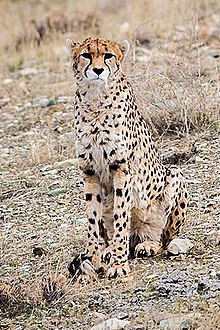| Asiatic cheetah | |
|---|---|

| |
| Scientific classification | |
| Domain: | Eukaryota |
| Kingdom: | Animalia |
| Phylum: | Chordata |
| Class: | Mammalia |
| Order: | Carnivora |
| Suborder: | Feliformia |
| Family: | Felidae |
| Subfamily: | Felinae |
| Genus: | Acinonyx |
| Species: | |
| Subspecies: | A. j. venaticus
|
| Trinomial name | |
| Acinonyx jubatus venaticus (Griffith, 1821)
| |

| |
| Range of the Asiatic cheetah in green | |
| Synonyms[2] | |
| |
The Asiatic cheetah (Acinonyx jubatus venaticus) is a critically endangered cheetah subspecies currently only surviving in Iran.[1] Its range once spread from the Arabian Peninsula and the Near East to the Caspian region, Transcaucasus, Kyzylkum Desert and northern South Asia, but was extirpated in these regions during the 20th century. The Asiatic cheetah diverged from the cheetah population in Africa between 32,000 and 67,000 years ago.[3]
The Asiatic cheetah survives in protected areas in the eastern-central arid region of Iran, where the human population density is very low.[4] Between December 2011 and November 2013, 84 individuals were sighted in 14 different protected areas, and 82 individuals were identified from camera trap photographs.[5] In December 2017, fewer than 50 individuals were thought to be remaining in three subpopulations that are scattered over 140,000 km2 (54,000 sq mi) in Iran's central plateau.[6] In January 2022, the Iranian Department of Environment estimated that there were only 12 Asiatic cheetahs comprising nine males and three females left in the country.[7] In 2023, a member of the Iranian Cheetah Society referred to 30 to 40 individuals living in Iran.[8]
- ^ a b Jowkar, H.; Hunter, L.; Ziaie, H.; Marker, L.; Breitenmoser-Würsten, C. & Durant, S. (2008). "Acinonyx jubatus ssp. venaticus". IUCN Red List of Threatened Species. 2008: e.T220A13035342.
- ^ Wozencraft, W. C. (2005). "Order Carnivora". In Wilson, D. E.; Reeder, D. M. (eds.). Mammal Species of the World: A Taxonomic and Geographic Reference (3rd ed.). Johns Hopkins University Press. p. 532. ISBN 978-0-8018-8221-0. OCLC 62265494.
- ^ Cite error: The named reference
molecowas invoked but never defined (see the help page). - ^ Farhadinia, M.S. (2004). "The last stronghold: cheetah in Iran" (PDF). Cat News. 40: 11–14. Archived (PDF) from the original on 21 December 2019. Retrieved 31 December 2012.
- ^ Farhadinia, M.S.; Hunter, L.T.; Jourabchian, A.; Hosseini-Zavarei, F.; Akbari, H.; Ziaie, H.; Schaller, G.B. & Jowkar, H. (2017). "The critically endangered Asiatic cheetah Acinonyx jubatus venaticus in Iran: a review of recent distribution, and conservation status". Biodiversity and Conservation. 26 (5): 1–20. Bibcode:2017BiCon..26.1027F. doi:10.1007/s10531-017-1298-8.
- ^ Khalatbari, L.; Jowkar, H.; Yusefi, G. H.; Brito, J. C. & Ostrowski, S. (2017). "The current status of Asiatic cheetah in Iran". Cat News. 66: 10−13.
- ^ "Iran says only 12 Asiatic cheetahs left in the country". The Times of Israel. 2022. Archived from the original on 10 January 2022.
- ^ "Protecting the Asiatic Cheetah". IUCN National Committee of the Netherlands. 2023.
